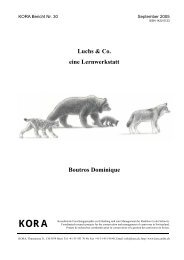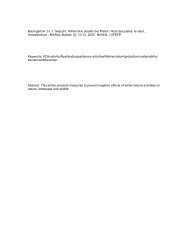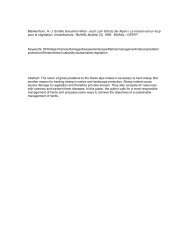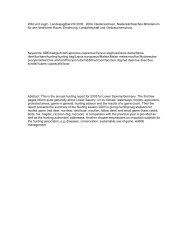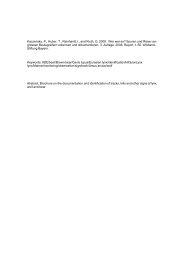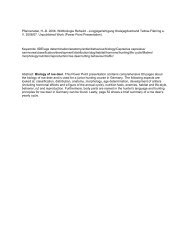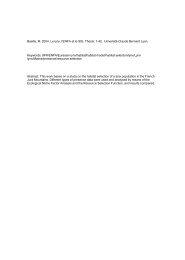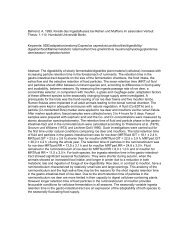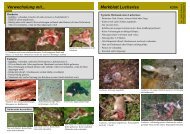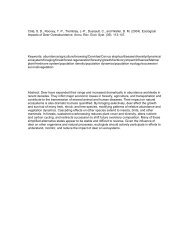6 Abstract/IntroductionKORA <strong>Bericht</strong> Nr. 13AbstractLynx had become extinct throughout most of Centraland Western Europe at the end of the 19 th century. Thiswas also the case for Switzerland. However, in 1971the Eurasian lynx was reintroduced into the SwissAlps. Further re-introduction programs followed in theSwiss Jura Mts, Slovenia and Croatia. All animals releasedcame from the same source population of theCarpathian Mts in Slovakia, and some of them havebeen closely related. As small, isolated populations aretheoretically vulnerable to genetic drift, where alleleswith low frequency are likely to disappear from thepopulation gene pool, a change in the occurrence ofdifferent coat patterns can be an indication for this. Inthe recent population of the Swiss Alps a temporalchange of the occurrence of different coat pattern typeswas found. Another possible indication is the loss ofthe non-spotted type in the Jura Mts population.In this study, a classification system for coat patternsin lynx was developed and five different coat patternswere defined: large spots, small spots, withoutspots, rosettes and small spots with rudimentary rosettes.The frequency of occurrence of these coat patternswas then compared between the two reintroducedpopulations in Switzerland and the sourcepopulation in the Carpathian Mts of Slovakia and anotherre-introduced population in Slovenia/Croatia. Additionallycoat patterns of historic lynx from Switzerlandwere analyzed. The dominant coat pattern type inthe historic Swiss population was non-spotted and inrecent populations large-spotted. Rosettes were foundonly recently. There existed a correlation between spatialand temporal distribution of the different coat patterntypes.1. Introduction1.1. Evolutionary history of coat patterns in felidsCarnivores show a wide variety of pelage colors and agreat diversity of markings on their coat – includingspots, stripes, bands and patches (Ortolani & Caro1996) (Appendix I, 1.). The current theory of felid coatpattern evolution proposes that the primitive pattern isone of relatively large spots which have a tendency tobreak down, first by forming a lighter center and thenby breaking up into smaller spots spaced into rosettesand later individually. At each step in this general decayof the basic pattern, striped patterns may develop(Weigel 1961). Werdelin & Olsson (1997) coded thecoat patterns of felids into six discrete categories: uniform,flecks, rosettes, vertical stripes, small blotchesand blotches. It is generally accepted that specific colorpatterns in mammals are genetically determined but theactual mechanisms that create the patterns are still unknown.Lynx belong to the spotted cats. Their colorationcan differ widely. Coats of northern lynx are moregreyish and less spotted than in southern Europe wherethe color changes into reddish-brown (Breitenmoserand Breitenmoser-Würsten 1998). The Eurasian lynxpresents a high phenotypical variability within the species.Grégorova (1997) defined a hypothesis about anew type of pattern: In principle, it is possible to distinguishtwo basic types of patterns: spotted (small orlarge spots) as the most frequent one and without spotsas the rarest one. The third type is defined as an intermediatetype (rosettes). This „new” type has hypotheticallyevolved from hybridization of the previous twotypes. In some felid species (e.g. the pampas cat, Feliscolocolo) there exist a spatial pattern of different coatpatterns (Garcia-Perea 1994) (Appendix I, 2.).1.2. History of lynx in Switzerland and currentstatusUntil 1900 lynx was exterminated in Western andSouthern Europe. Some small populations survived inthe Balkan and the Carpathian Mts. In central Switzerlandlynx had already disappeared during 17 th century.In the Jura Mts the species survived until the beginningand in the Alps until the end of the 19 th century. Ragni(1993) analyzed coat patterns of the extinct Alpinepopulation and recognized a non-spotted type(concolor) as predominant and concluded that the Alpinelynx represented a differentiated taxon. In 1971,the Swiss government decided to re-introduce lynx intoSwitzerland and four years later the first animals havebeen released in the Alps (Breitenmoser 1983, Breitenmoserand Baettig 1992, Haller 1992). The animalsoriginated from the Carpathian Mts in Slovakia (zoo inOstrava). In addition to the official releases in Obwalden,Waadt and Neuenburg there were some illegal releasesin the Alps and in the Jura Mts (Breitenmoser1983, Haller 1992). In the founding population onlyvery few individuals were released. Additionally, accordingto Koubek and Cerveny (1996), some of themwere probably closely related (mother-son or siblings).Today, there are about 75–80 adult and subadult lynxliving in the Swiss Alps. The population in the JuraMts and in the Alps are still small and isolated andtherefore theoretically vulnerable to genetic drift,where alleles with low frequency are likely to disappearfrom the population gene pool (Griffiths et al.1996). Beltran and Delibes (1993) found preliminaryevidence for this in the Iberian lynx (Lynx pardinus) inCoto Doñana, Spain, where the population of approximately40–50 lynx was isolated since the early 1960s.A project on genetic variability, analyzing inbreedingproblems, shows that originally three coat patternswere present in the population, but today no animal exhibitsthe rare small-spotted pattern (Nowell & Jackson1996). In Switzerland intensive field studies since 1983
Juni 2002 Introduction / Material and Methods/7had provided extensive material on 87 lynx that werecaught over the years. At each capture, pictures of theanimals were taken. Anecdotal observations on differencesin coat patterns over space and time were madeduring the last few years.According to these observations, the following hypotheseswere formulated: i) Lynx have clearly distinguishablecoat patterns. (ii) The occurrence of thesedifferent types of coat patterns is different between thetwo re-introduced populations in Switzerland and haschanged over time since the releases in the early 1970s.(iii) Genetic drift has occurred since the releases due toa small founder population, and therefore the occurrenceof the different types of coat patterns in the reintroducedpopulations are different from the sourcepopulation in the Carpathian Mts of Slovakia. The aimof this study therefore was to (i) develop a classificationsystem for the different coat patterns observed andassign all available lynx individuals to a defined coatpattern type, (ii) compare the occurrence of these coatpatterns between the two re-introduced lynx populationsin Switzerland and the historic population and(iii) compare the occurrence of these coat patterns inSwitzerland with the occurrence in the source populationof Slovakia and another re-introduced populationin Slovenia/Croatia.2. Material and Methods2.1. Available materialsFor this study I collected all available information on342 individuals of the species Lynx lynx from populationsin Switzerland, Slovakia, Croatia and Slovenia(Table 1). I created a form with all necessary information(location [last origin, place where the lynx werecaught/found/dead, coordinates of caught/found], sex,age, year of birth, relatives) needed per individual andsent it to collaborators in Slovakia, Croatia and Slovenia(Appendix II). From museums of natural history inSwitzerland I also received a list with informationabout the lynx specimens stored. All this informationwas collected in a table where I setup a database(Microsoft Access) with all available lynx that couldprovide information on coat patterns from Switzerland(Appendix IV).From the two Swiss populations, pictures from captures,photo traps, video recordings and mortalitieswere available. From dead lynx stored in museums, Ifirst had to take pictures of pelts and mounts. A standardizedprocedure was applied: Using a grey cloth asbackground (only with pelts) and next to every objecton every picture placed a ruler. The camera was aNikon FE2 with a 55 macro lens (28-85, 70-210) and aTable 1. All available specimen.Material Type of specimen Number of specimenSwitzerland Total 228Monitored lynx in telemetry project Pictures from captures (various field studies in Switzerland) 87Photo-trapsPictures from photo traps (population estimation study, predatoridentification program)Video Pictures from videos (predator identification program) 9Lynx in museum Lynx hides and stuffed specimen in museums in Switzerland :MountsPeltsAnimals not yet mountedOther dead lynxPictures from dead lynx (<strong>Kora</strong>'s database of dead lynx), pelts,mountsSlovakia Total 47Lynx in Zoo Pictures of animals 5Lynx in private Pictures of pelts 2Dead lynx Pictures of pelts 40Croatia Total 45Lynx pelt of hunter Pictures of pelts and mounts 45Slovenia Total 22Lynx in zoo Pictures of animals 5Lynx in wild cat project Pictures of animals 1Monitored lynx in telemetry project Pictures of captures 4Dead lynx Pictures of pelts 12134351223Total Objects 342



